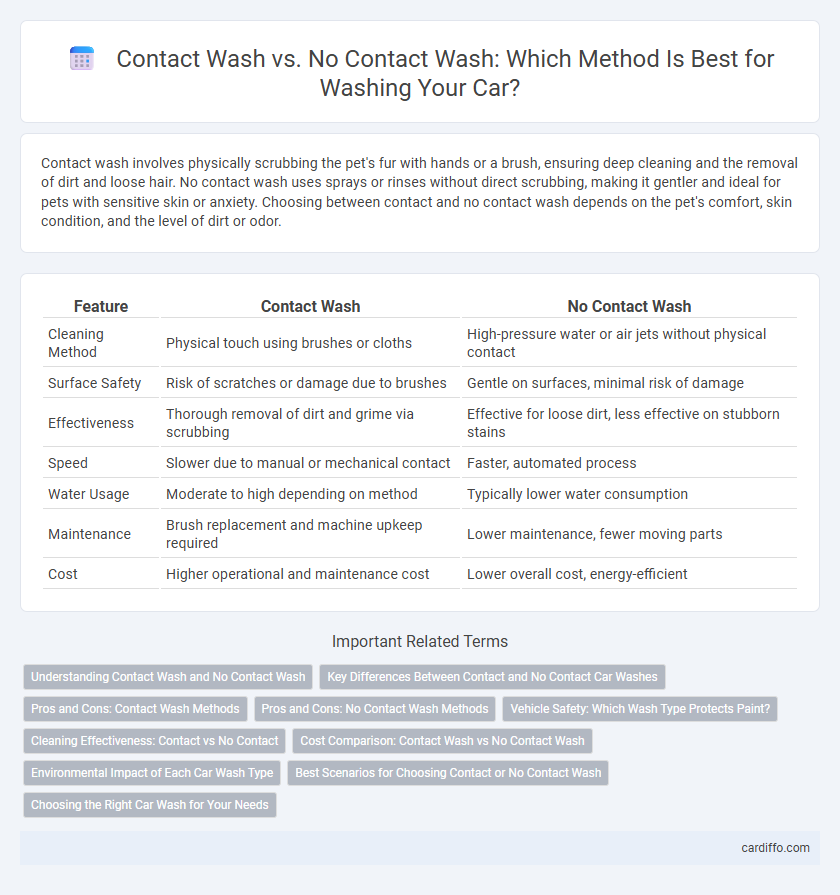Contact wash involves physically scrubbing the pet's fur with hands or a brush, ensuring deep cleaning and the removal of dirt and loose hair. No contact wash uses sprays or rinses without direct scrubbing, making it gentler and ideal for pets with sensitive skin or anxiety. Choosing between contact and no contact wash depends on the pet's comfort, skin condition, and the level of dirt or odor.
Table of Comparison
| Feature | Contact Wash | No Contact Wash |
|---|---|---|
| Cleaning Method | Physical touch using brushes or cloths | High-pressure water or air jets without physical contact |
| Surface Safety | Risk of scratches or damage due to brushes | Gentle on surfaces, minimal risk of damage |
| Effectiveness | Thorough removal of dirt and grime via scrubbing | Effective for loose dirt, less effective on stubborn stains |
| Speed | Slower due to manual or mechanical contact | Faster, automated process |
| Water Usage | Moderate to high depending on method | Typically lower water consumption |
| Maintenance | Brush replacement and machine upkeep required | Lower maintenance, fewer moving parts |
| Cost | Higher operational and maintenance cost | Lower overall cost, energy-efficient |
Understanding Contact Wash and No Contact Wash
Contact wash involves direct physical touch between cleaning equipment and the surface, effectively removing stubborn dirt and grime through friction. No contact wash relies on high-pressure water jets and specialized detergents to clean surfaces without touching them, reducing the risk of scratches or damage. Understanding the differences helps in selecting the appropriate method based on surface sensitivity, contamination level, and cleaning efficiency requirements.
Key Differences Between Contact and No Contact Car Washes
Contact car washes rely on physical brushes and cloths to scrub the vehicle's surface, which may cause minor scratches or swirl marks over time. No contact car washes use high-pressure water jets and specialized detergents to clean the car without direct contact, reducing the risk of paint damage. The key difference lies in the cleaning method--mechanical abrasion versus pressurized water--impacting vehicle safety and finish preservation.
Pros and Cons: Contact Wash Methods
Contact wash methods provide thorough cleaning by physically scrubbing surfaces, effectively removing stubborn dirt, grease, and stains. These methods can be labor-intensive and may cause surface abrasion or damage if not executed carefully. Ideal for heavy-duty cleaning tasks, contact washes offer precise contamination removal but require more time and resources compared to no-contact alternatives.
Pros and Cons: No Contact Wash Methods
No contact wash methods, such as touchless car washes using high-pressure water jets and specialized detergents, effectively reduce the risk of surface scratches and swirl marks caused by brushes or cloths. These methods minimize human error and physical abrasion, preserving the vehicle's paint quality over time. However, no contact washes may struggle with removing heavy dirt or stubborn contaminants, occasionally requiring follow-up hand washing for thorough cleanliness.
Vehicle Safety: Which Wash Type Protects Paint?
Contact washes use brushes or cloths that physically touch the vehicle's surface, potentially causing micro-scratches and swirl marks on the paint over time, impacting long-term vehicle safety and aesthetics. No contact washes rely on high-pressure water jets and detergents to remove dirt without physical abrasion, significantly reducing the risk of paint damage and preserving the vehicle's finish. Choosing a no contact wash is generally safer for maintaining the integrity and resale value of automotive paint.
Cleaning Effectiveness: Contact vs No Contact
Contact wash uses direct brush or sponge contact to physically scrub surfaces, effectively removing stubborn dirt and grime from vehicle exteriors. No contact wash relies on high-pressure water jets and detergents to clean without touching the surface, reducing the risk of scratches but sometimes less effective on heavy contaminants. Cleaning effectiveness depends on contamination type; contact washes excel at deep cleaning, while no contact washes offer safer, chemical-based cleaning for light dirt.
Cost Comparison: Contact Wash vs No Contact Wash
Contact wash systems generally incur higher costs due to the use of brushes and mechanical components that require regular maintenance and replacement. No contact wash methods often have lower operational expenses because they rely on high-pressure water jets and detergents, minimizing wear and tear on equipment. Long-term cost analysis reveals no contact wash can be more economical for facilities prioritizing reduced maintenance and equipment longevity.
Environmental Impact of Each Car Wash Type
Contact wash methods often involve brushes or cloths that can scratch vehicle surfaces and use significant amounts of water and chemicals, potentially leading to higher environmental contamination. No contact wash systems utilize high-pressure water jets and eco-friendly detergents, minimizing water usage and chemical runoff while reducing the risk of physical damage to cars. Studies indicate that no contact washes generally offer a more sustainable option by conserving water and limiting harmful effluents compared to traditional contact washes.
Best Scenarios for Choosing Contact or No Contact Wash
Contact wash is ideal for vehicles with heavy dirt, mud, or grime buildup, ensuring thorough cleaning through direct scrubbing action. No contact wash suits delicate finishes and newer cars with protective coatings, minimizing the risk of scratches by using high-pressure water jets and detergents without physical contact. Choosing between the two depends on the vehicle's condition, surface sensitivity, and the desired level of cleaning intensity.
Choosing the Right Car Wash for Your Needs
Choosing the right car wash depends on factors such as convenience, budget, and vehicle care preferences. Contact washes often provide a thorough cleaning but may risk minor paint scratches, while no-contact washes use high-pressure water and detergents to minimize surface damage. Assessing your vehicle's condition and maintenance priorities ensures the best option for preserving its appearance and value over time.
Contact Wash vs No Contact Wash Infographic

 cardiffo.com
cardiffo.com